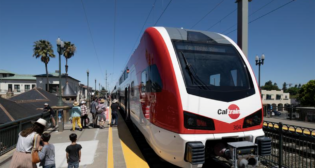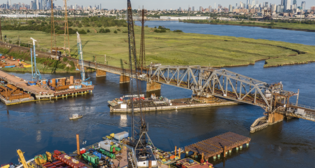
Austin LRT plan criticized … by rail advocates
Written by Lyndon HenryCustomarily, in almost any urban area, you'd expect your strongest rail transit advocates to be rallying around an official rail plan as it heads toward a possible ballot initiative. But in Austin, Tex., today, that's definitely not the case.
A group of avid transit activists has been questioning the official City of Austin plan for 16.5 miles of “Urban Rail” (actually, a full-performance light rail transit, or LRT, plan that has mutated from an original streetcar plan). They argue that it’s literally off the track, ignoring where the biggest need is, and investing about 1.4 billion bucks to go where it isn’t.
This group of pro-rail nitpickers is currently small, but it comprises some of the most venerable and influential transit advocates in the city — including yours truly and a longtime colleague, Dave Dobbs, publisher of the well-respected Light Rail Now website. I’m the guy that originally proposed LRT for Austin, way back in the 1970s (whew), and, following the ballot failure of that plan in 2000 (by a very narrow margin of less than 2,000 votes), Dave and I concocted the scheme for running DMUs on the railway owned by Capital Metro, the transit authority. You know … the scheme that today runs as the MetroRail Red Line.
 Basically, the city’s neediest travel corridor runs along a couple of major central-city thoroughfares called Lamar and Guadalupe, which channel a huge travel flow from the north and northwest down southward through the heart of the city and into the Core Area—including the University of Texas (plus the fourth-densest residential neighborhood in the state), the Capitol Complex (state Capitol plus a cluster of state offices), and Austin’s downtown. (A depiction of the proposed service, envisioned as LRT, is at left.)
Basically, the city’s neediest travel corridor runs along a couple of major central-city thoroughfares called Lamar and Guadalupe, which channel a huge travel flow from the north and northwest down southward through the heart of the city and into the Core Area—including the University of Texas (plus the fourth-densest residential neighborhood in the state), the Capitol Complex (state Capitol plus a cluster of state offices), and Austin’s downtown. (A depiction of the proposed service, envisioned as LRT, is at left.)
MetroRail, originally envisioned as a “demonstration” starter line, and built at very low cost (about $4 million a mile), has gained public respect for attracting just under 2,000 rider-trips a day out of cars, SUVs, and pickup trucks. Why such relatively low ridership for a rail transit line? By following a former Southern Pacific branch line, MetroRail bypasses the central corridor and the Core Area in a leisurely dogleg through the east side of the city, ending up in the lower southeastern corner of downtown. Now the new Urban Rail plan (promoted by the City, not Capital Metro) also fails to serve this crucial travel corridor, thus likewise missing the target.
For about the past six years, we’ve been raising concerns about these route weaknesses. The official response has consistently been that the route plan isn’t “set in stone” … but, well, it’s set in stone. There’s talk of a possible bond election next November to fund the first phase.
All this should become clearer in an article I’ve just published, with more details, maps, and other graphics, on the Light Rail Now website: Austin, Texas: City’s Urban Rail Plan Needs Major Overhaul
The official Urban Rail site, with full information on the plan, is here:
You’d think that, in today’s contentious political atmosphere (with some GOP politicians trying to scuttle dedicated fuel-tax funding for transit), local planners would realize a major rail project like this needs all the help it can get. But instead, the attitude seems to be, “Damn the critics’ torpedoes — full speed ahead!”
But if some of the most knowledgeable and enthusiastic rail supporters in the city think it’s flawed, what about voters at large? Doesn’t seem to bode so well.



